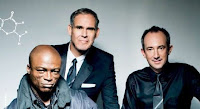
The Hawaiian islands are the setting for one of the most fascinating experiments in evolution in real time that I know of. There, the males in a population of crickets have gone from singers to almost entirely silent in just a few years.
This species of cricket (
Teleogryllus oceanicus) lives across a wide range of Pacific locations, from Australia (where they started) to Hawaii (a much more recent introduction). Male crickets sing to attract females, so there’s selection to keep singing. These same songs, however, can attract small parasitoid flies that lay their eggs in the male crickets and kill them, so there’s selection pressure against singing. This parasitoid doesn’t live everywhere the cricket does; the two overlap in the Hawaiian islands alone.
A few years ago, a mutation appeared in the male crickets called the “flatwing” mutation in Kauai. Males with this mutation literally
cannot sing. Normally, this would be bad news for males with the mutation – no singing means no mating!
But context is everything.
In the context of an environment loaded with parasitoid flies that track hosts down by listening for the song of that host, the flatwing mutation took off like a rocket. The parasitoid flies couldn’t find the males! In this particular population, about
90% of males are now silent flatwing males (Zuk et al. 2006).

The question this paper tries to answer is, “If females need to hear singing to mate, how did the flatwing mutant spread?” If song was necessary for mating, it wouldn’t matter how much protection being silent gave you from the parasitoid flies. Zero mating means zero copies of the flatwing gene going on to the next generation.
Turns out that there was an hypothesis that predicted island females would be less choosy about their mates (Kaneshiro 1980). The logic went that in small, restricted populations like newly colonized islands, picky females would be unlikely to find a mate living up to their high standards. There would be selection for the unselective, as it were.
Because this cricket has such a wide distribution, this provided an opprtunity to test this hypothesis. Tinghitella and colleagues paired up males and females from across the species’ range. The males were all singing, except for the Kauai males, which were all silent flatwings. The females had no choice of mates, just the decision to mate or not.
The first finding was that singing males got more matings. No surprise there. But females from
every population would occasionally mate with a flatwing. But was there a difference in female preference according to location?

Not only was there a difference, but the difference was that predicted by the hypothesis. Females from mainland Australian populations were more reluctant to mate with silent males than females from
any of the island populations.
Thus, the female crickets living on islands were pre-disposed to take a chance on flatwing males, allowing the mutation to spread when it occurred. The observant will note that the Kauai females are the least discriminatory against flatwings of all the island dwelling populations. It will be interesting to find out if that proportion goes up over time, if females can benefit from having sons that don’t advertise their presence to parasitoids.
It’s going to be fascinating to watch the dynamics of these three players (males, females, parasitoids) as time goes on.
ReferencesKaneshiro KY. 1980. Sexual isolation, speciation and the direction of evolution.
Evolution 34: 437–444.
Tinghitella, R., & Zuk, M. (2009). ASYMMETRIC MATING PREFERENCES ACCOMMODATED THE RAPID EVOLUTIONARY LOSS OF A SEXUAL SIGNAL Evolution DOI: 10.1111/j.1558-5646.2009.00698.xZuk M, Rotenberry JT, Tinghitella RM. 2006. Silent night: adaptive disappearance of a sexual signal in a parasitized population of field crickets.
Biology Letters 2: 521-524.
http://dx.doi.org/10.1098/rsbl.2006.0539
 A short review of Rock Stars of Science.
A short review of Rock Stars of Science.























